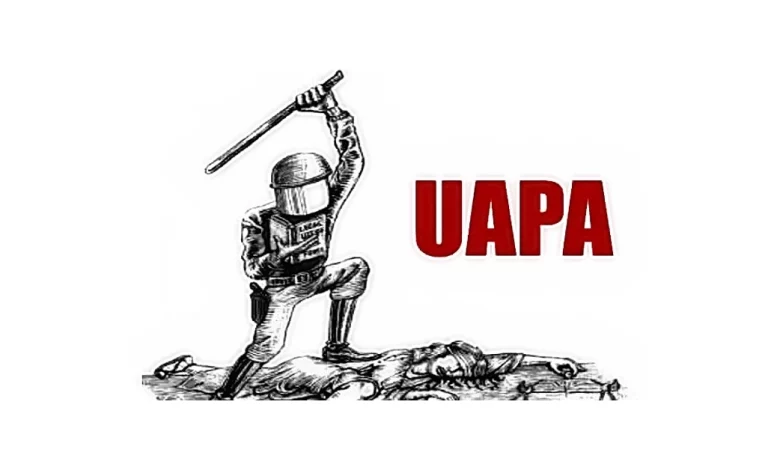The origin of draconian laws can be traced back to the 7th Century BCE, when an Athenian statesman named Draco brought about stringent laws as a punitive measure for minor acts. His legal code favoured wealthy landowners and aimed to restore “order” within society. Over time, the term “draconian” came to be associated with harsh laws lacking proportionality, focused on restoring ‘social’ order.
Draconian laws in India find their roots in the colonial era when the British Raj implemented repressive legislation in order to suppress dissent. These laws helped in maintaining their hegemony over the Indian subcontinent. Laws like the Bengal Regulation Act of 1818, the Rowlatt Act etc. were among the first preventive detention laws in India. The legacy of oppression through colonial- era draconian laws continues even decades after 1947. Draconian laws today mirror colonial-era laws in their principles of curbing dissent and not needing evidence to prove suspicions.
Hush the Dissent
These laws violate the basic principles of natural justice required to carry out a trial in a fair manner to ensure that no innocent is punished. Laws like UAPA (Unlawful Activities Prevention Act) do not even give an opportunity to be heard to the accused. They can be kept behind bars, unaware of the charges, without commencement of trial amounting to a gross miscarriage of justice. Even if the accused is eventually acquitted, they would have served years in jail for a crime he didn’t commit. There is a complete overturn of the legal principle of “bail is the rule and jail is the exception” in such cases. A Ministry of Home Affairs report placed in Lok Sabha shows that between 2016-20, 24,134 people were arrested out of which only 212 were convicted, so less than 3% of the arrests made under UAPA ends up in conviction! Its only use is to suppress dissent of the people against the state machinery. Of the total arrests made under UAPA in 2020, Jammu and Kashmir with 346 and Manipur with 225 arrests saw the second and third most arrests in the country only to be led by Uttar Pradesh with 361 arrests.
Student activists who participated in protests against CAA-NRC like Safoora, Umar, Natasha, Devangana, and others, journalists like Siddique Kappan who was covering the state’s role in the destruction of evidence in the Hathras case, Rupesh Kumar Singh who reported on industrial waste being dumped in tribal land, activists like Sudha Bhradwaj, Gautam Navalakha, Anand Teltumbde, and others charged with the Bhima-Koregaon conspiracy are some of the instances where the state has actively tried to suppress dissent by invoking UAPA.
Army Impunity
The Armed forces of the Indian State enjoy special powers where they can indulge in any crimes and are shielded from criminal prosecution under the Armed Forces (Special Powers) Act. AFSPA is modelled after The Armed Forces Special Powers Ordinance of 1942 which was promulgated by the British to suppress the Quit India movement. The AFSPA came into the limelight time and again when allegations of rape were levelled against the Indian army in the North-East and Kashmir. It is this law which is protecting from persecution, the perpetrators who riddled the body of Thangjam Manorama with bullets, mutilated her genitals, and claimed that they shot her as she was allegedly trying to escape. In the case of the Mon district killing where personnels of 21 Para SF regiment opened fire killing 14 Naga civilians including 6 coal mine workers, the state police could not prosecute 30 army personnel as they failed to take the centre’s permission. In Kunan-Poshpora the victims of mass rape in two villages of Kashmir still await justice after the passage of two decades, due to the existence of AFSPA.
The Act does not define the characteristics of a “disturbed area”. Section 4 of the act bestows upon army personnel the right to enter premises without search warrant and the right to fire and kill people to maintain “public order”. Section 6 of the act protects the army personnel from any criminal prosecution or legal action against acts being conducted by the personnel. It considers shooting and killing people in the “disturbed area” as an action done or purported to be done in the exercise of the powers conferred by the AFSPA act and gives them protection.
Confined Conscience
Freedom of thought and expression is merely present in the constitution, however, the Colonial Legacy is being carried forward and practised through the Sedition Act. A plain reading of section 124A of the IPC shows how having and promulgating an idea or thought is considered a crime. This shows nothing but the imposition of a colonial mindset where the subjects cannot question the ‘rulers’. The existence of such laws makes one wonder if this is a democracy. This harsh law was invoked on many people, including the mother of a 12-year old child who performed in an anti-CAA skit in a school in Bidar, people who did not stand up when the National Anthem was played in a movie theatre in Kerala and Vinod Dua, who merely stated the non-availability of PPE kits in a video during Covid etc.
There is a common misconception that draconian laws are misused. However, these are not misused rather aptly used. These laws, under the garb of protecting people from “terrorists”, help the ruling class preserve its oppressive regime. The Colonizers and their standing army may have left the country, however, their laws and structure still remain very much alive to suppress people. It is only through a united movement led by radical farmers, workers and students, that we can emancipate the people of India from the colonial horrors.



